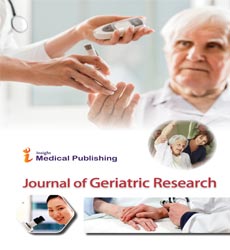Physiotherapy for Geriatric and Neurological Patients
Magdalena Hagovska*
PJ Safarik University, Košice, Slovak Republic
- *Corresponding Author:
- Magdalena Hagovska
Assistant Professor, Physiotherapy Department of Physiatry
Balneology, and Medical, Rehabilitation, Faculty of Medicine
PJ Safarik University, Košice, Slovak Republic
Tel: 00421944400846
E-mail: lehag@centrum.sk
Received date: November 16, 2016; Accepted date: November 18, 2016; Published date: January 02, 2017
Citation: Hagovska M. Physiotherapy for Geriatric and Neurological Patients. J Geriatr Med Res. 2017, 1:1.
Copyright: © 2017 Hagovska M. This is an open-access article distributed under the terms of the Creative Commons Attribution License, which permits unrestricted use, distribution, and reproduction in any medium, provided the original author and source are credited.
My Research Activity Covers Following Areas
Physiotherapeutic treatment of cognitive and coordination disorders in geriatric and neurological patients.
My professional experience is connected with examining the relationship between the aging process and physical activity. This means the impact of physical activity on physiological, psychological, social aspects, everyday activities and quality of life of older adults with and without neurological diagnosis (e.g. stroke, Parkinson’s disease, sclerosis multiplex, Alzheimer’s disease, mild cognitive impairment and balance disorders. The prevention of falls in older adults with and without neurological diagnosis, the impact of physical activity on cognition and depression in the older population if there is a functional loss of mobility and inability to perform activities of daily living (ADLs) predominate.
My activity also covers examining the effect of a cognitive training and cognitive rehabilitation methodology, testing the effect of cognitive and movement interventions within the framework of preventing cognitive functional deterioration in seniors, consisting of exercises for balance improvement, which can be performed by means of multifactorial interventions with a multi-component or single-component training programme, and looking at the impact of exercises on cognitive functioning in patients with cognitive decline.
Rehabilitation treatment of urinary incontinence and impact on quality of life of patients (men and women) with stress urgency and mixed urinary incontinence.
My Further Activity Comprises the Evaluation of: Pelvic Floor Muscle Dysfunction in Older People
1. The effect of rehabilitation treatment in men after radical prostatectomy in the prevention and treatment of urinary incontinence.
2. Various types of exercise for the treatment of urinary incontinence in elderly women after hysterectomy.
3. Physiotherapy aimed at the prevention and treatment of prolapses of the pelvic floor in older women.
4. New trends in diagnosis and treatment of pelvic floor physiotherapy, focusing on the elderly population.
5. Monitoring the relationship between urinary incontinence and dysfunction of posture and balance dysfunction in older men and women.
6. The effect of physiotherapy in the treatment of other pelvic floor dysfunctions, pelvic pain, etc.
Vertebrolgy and musculoskeletal medicine in assessment of acute and chronic pain and disability in older people.
This means the impact of physical activity, and special treatment methods and concepts on pain and disability in older people with diagnosis (e.g. disc protrusion, extrusion, sequestration, spinal stenosis, spondylolisthesis, peripheral joint dysfunction, nonspecific pain); skeletal problems including osteoporosis and osteoarthritis conditions such as knee and hip replacements; rehabilitation maintaining functional independence in the elderly, recovery of musculoskeletal function, particularly recovery from joint, tendon, or ligament repair and physical medicine.
The effect of different types of exercises and concepts in terms of decreased pain and functional disability in older people. New trends in diagnosis and treatment of pain within physiotherapy, focusing on the elderly population. Monitoring the relationship between pain and structural changes of the spine and joints in older people.
My professional activity also includes the development, implementation, and evaluation of physical activity programmes among older adults.
I have experience with scientific studies, e.g. randomized control studies, non-randomized studies, controlled case studies, and cross-sectional studies.
Open Access Journals
- Aquaculture & Veterinary Science
- Chemistry & Chemical Sciences
- Clinical Sciences
- Engineering
- General Science
- Genetics & Molecular Biology
- Health Care & Nursing
- Immunology & Microbiology
- Materials Science
- Mathematics & Physics
- Medical Sciences
- Neurology & Psychiatry
- Oncology & Cancer Science
- Pharmaceutical Sciences
